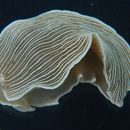Look Alikes
provided by Invertebrates of the Salish Sea
How to Distinguish from Similar Species: This species is very distinctive. No other local species has the combination of the anus on the right side, longitudinal white ridges on the dorsum, and no cerata.
- license
- cc-by-nc-sa
- copyright
- Rosario Beach Marine Laboratory
Habitat
provided by Invertebrates of the Salish Sea
Sandy bottoms
- license
- cc-by-nc-sa
- copyright
- Rosario Beach Marine Laboratory
Distribution
provided by Invertebrates of the Salish Sea
Geographical Range: Gulf of Alaska to Panama
- license
- cc-by-nc-sa
- copyright
- Rosario Beach Marine Laboratory
Habitat
provided by Invertebrates of the Salish Sea
Depth Range: Mostly subtidal, 1 to 230 m
- license
- cc-by-nc-sa
- copyright
- Rosario Beach Marine Laboratory
Comprehensive Description
provided by Invertebrates of the Salish Sea
This nudibranch has white longitudinal ridges on a brownish background. It has a white or cream line outlining the edge of the dorsum. Its anus is on the right side of the body, on a papilla in a groove between the dorsum and the foot. The gills are also located in this groove. It has no dorsal outgrowths except for the rhinophores. The rhinophores have longitudinal grooves in the clavus and project anteriorly out of a notch at the front of the mantle. Length to 7 cm.
- license
- cc-by-nc-sa
- copyright
- Rosario Beach Marine Laboratory
Comprehensive Description
provided by Invertebrates of the Salish Sea
Biology/Natural History: This species eats sea pens such as Ptilosarcus gurneyi.. May be largely buried in the sand with primarily the rhinophores projecting above the surface of the sand. Eggs are laid in a pale pinkish-brown spiral chain of capsules. According to Baltzley et al.,, many gastropods, including this species, have a special network of pedal ganglia in their foot which assists in crawling. The two main neurons involved produce pedal peptides which elicit an increase in the rate of beating of cilia on the foot, resulting in crawling.
- license
- cc-by-nc-sa
- copyright
- Rosario Beach Marine Laboratory
Armina californica
provided by wikipedia EN
Armina californica is a species of sea slug, a nudibranch, a marine gastropod mollusk in the family Arminidae.[1]
This species occurs in the Eastern Pacific Ocean from Vancouver Island to Panama. It can commonly be found in a soft-bottom habitat[2] from 1-230 meters in depth.[3] Armina californica is characterized by longitudinal ridges of varying colors including light pink, cream, and brown.[3] Features that differentiate Armina californica from the larger Armina species are separated rhinophores, rachidian teeth with 8-13 elongated denticles, and lateral teeth with 7-9 triangular denticles.[2]
References
-
^ a b Rosenberg, G.; Bouchet, P. (2011). Armina californica (J. G. Cooper, 1863). Accessed through: World Register of Marine Species at http://www.marinespecies.org/aphia.php?p=taxdetails&id=558913 on 2012-04-15
-
^ a b Baez, Diana P.; Ardila, Nestor; Valdes, Angel; Acero P., Arturo (2011). Taxonomy and phylogeny of Armina (Gastropoda: Nudibranchia: Arminidae) from the Atlantic and eastern Pacific. Cambridge University Press (published 21 January 2011). p. 1113.
-
^ a b McDonald, Gary R.; Nybakken, James W. (1980). Guide to the Nudibranchs of California: including most species found from Alaska to Oregon. Melbourne, Florida, U.S.A.: American Malacologists, Inc. p. 58. ISBN 0-915826-08-9.
- SeaSlug info at: [1]
- Slugsite info at: [2]
- Baez D.P., Ardila N., Valdés A. & Acero A. (2011) Taxonomy and phylogeny of Armina (Gastropoda: Nudibranchia: Arminidae) from the Atlantic and eastern Pacific. Journal of the Marine Biological Association of the United Kingdom 91(5): 1107-1121.
- Gosliner T.M. & Fahey S.J. (2011) Previously undocumented diversity and abundance of cryptic species: a phylogenetic analysis of Indo-Pacific Arminidae Rafinesque, 1814 (Mollusca: Nudibranchia) with descriptions of 20 new species of Dermatobranchus. Zoological Journal of the Linnean Society 161: 245–356. p. 2582

- license
- cc-by-sa-3.0
- copyright
- Wikipedia authors and editors
Armina californica: Brief Summary
provided by wikipedia EN
Armina californica is a species of sea slug, a nudibranch, a marine gastropod mollusk in the family Arminidae.
This species occurs in the Eastern Pacific Ocean from Vancouver Island to Panama. It can commonly be found in a soft-bottom habitat from 1-230 meters in depth. Armina californica is characterized by longitudinal ridges of varying colors including light pink, cream, and brown. Features that differentiate Armina californica from the larger Armina species are separated rhinophores, rachidian teeth with 8-13 elongated denticles, and lateral teeth with 7-9 triangular denticles.
- license
- cc-by-sa-3.0
- copyright
- Wikipedia authors and editors

